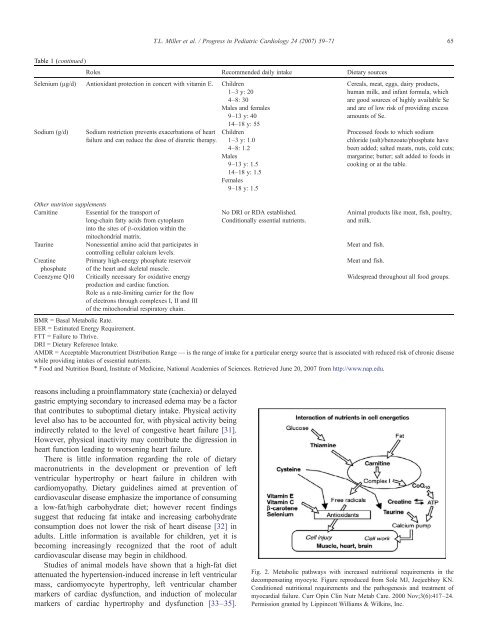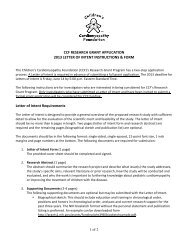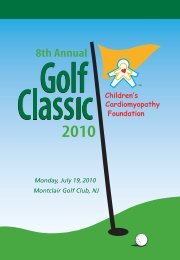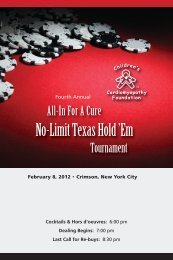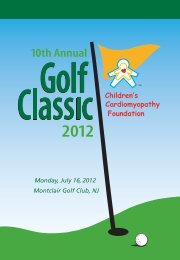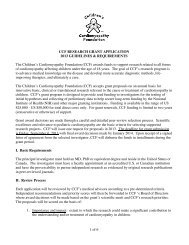Nutrition in pediatric cardiomyopathy - Children's Cardiomyopathy ...
Nutrition in pediatric cardiomyopathy - Children's Cardiomyopathy ...
Nutrition in pediatric cardiomyopathy - Children's Cardiomyopathy ...
You also want an ePaper? Increase the reach of your titles
YUMPU automatically turns print PDFs into web optimized ePapers that Google loves.
T.L. Miller et al. / Progress <strong>in</strong> Pediatric Cardiology 24 (2007) 59–7165Table 1 (cont<strong>in</strong>ued)Roles Recommended daily <strong>in</strong>take Dietary sourcesSelenium (μg/d) Antioxidant protection <strong>in</strong> concert with vitam<strong>in</strong> E. Children Cereals, meat, eggs, dairy products,1–3 y:204–8: 30Males and females9–13 y: 4014–18 y: 55human milk, and <strong>in</strong>fant formula, whichare good sources of highly available Seand are of low risk of provid<strong>in</strong>g excessamounts of Se.Sodium (g/d)Sodium restriction prevents exacerbations of heartfailure and can reduce the dose of diuretic therapy.Other nutrition supplementsCarnit<strong>in</strong>e Essential for the transport oflong-cha<strong>in</strong> fatty acids from cytoplasm<strong>in</strong>to the sites of β-oxidation with<strong>in</strong> themitochondrial matrix.Taur<strong>in</strong>eNonessential am<strong>in</strong>o acid that participates <strong>in</strong>controll<strong>in</strong>g cellular calcium levels.Creat<strong>in</strong>e Primary high-energy phosphate reservoirphosphate of the heart and skeletal muscle.Coenzyme Q10 Critically necessary for oxidative energyproduction and cardiac function.Role as a rate-limit<strong>in</strong>g carrier for the flowof electrons through complexes I, II and IIIof the mitochondrial respiratory cha<strong>in</strong>.Children1–3 y: 1.04–8: 1.2Males9–13 y: 1.514–18 y: 1.5Females9–18 y: 1.5No DRI or RDA established.Conditionally essential nutrients.Processed foods to which sodiumchloride (salt)/benzoate/phosphate havebeen added; salted meats, nuts, cold cuts;margar<strong>in</strong>e; butter; salt added to foods <strong>in</strong>cook<strong>in</strong>g or at the table.Animal products like meat, fish, poultry,and milk.Meat and fish.Meat and fish.Widespread throughout all food groups.BMR = Basal Metabolic Rate.EER = Estimated Energy Requirement.FTT = Failure to Thrive.DRI = Dietary Reference Intake.AMDR = Acceptable Macronutrient Distribution Range — is the range of <strong>in</strong>take for a particular energy source that is associated with reduced risk of chronic diseasewhile provid<strong>in</strong>g <strong>in</strong>takes of essential nutrients.⁎ Food and <strong>Nutrition</strong> Board, Institute of Medic<strong>in</strong>e, National Academies of Sciences. Retrieved June 20, 2007 from http://www.nap.edu.reasons <strong>in</strong>clud<strong>in</strong>g a pro<strong>in</strong>flammatory state (cachexia) or delayedgastric empty<strong>in</strong>g secondary to <strong>in</strong>creased edema may be a factorthat contributes to suboptimal dietary <strong>in</strong>take. Physical activitylevel also has to be accounted for, with physical activity be<strong>in</strong>g<strong>in</strong>directly related to the level of congestive heart failure [31].However, physical <strong>in</strong>activity may contribute the digression <strong>in</strong>heart function lead<strong>in</strong>g to worsen<strong>in</strong>g heart failure.There is little <strong>in</strong>formation regard<strong>in</strong>g the role of dietarymacronutrients <strong>in</strong> the development or prevention of leftventricular hypertrophy or heart failure <strong>in</strong> children with<strong>cardiomyopathy</strong>. Dietary guidel<strong>in</strong>es aimed at prevention ofcardiovascular disease emphasize the importance of consum<strong>in</strong>ga low-fat/high carbohydrate diet; however recent f<strong>in</strong>d<strong>in</strong>gssuggest that reduc<strong>in</strong>g fat <strong>in</strong>take and <strong>in</strong>creas<strong>in</strong>g carbohydrateconsumption does not lower the risk of heart disease [32] <strong>in</strong>adults. Little <strong>in</strong>formation is available for children, yet it isbecom<strong>in</strong>g <strong>in</strong>creas<strong>in</strong>gly recognized that the root of adultcardiovascular disease may beg<strong>in</strong> <strong>in</strong> childhood.Studies of animal models have shown that a high-fat dietattenuated the hypertension-<strong>in</strong>duced <strong>in</strong>crease <strong>in</strong> left ventricularmass, cardiomyocyte hypertrophy, left ventricular chambermarkers of cardiac dysfunction, and <strong>in</strong>duction of molecularmarkers of cardiac hypertrophy and dysfunction [33–35].Fig. 2. Metabolic pathways with <strong>in</strong>creased nutritional requirements <strong>in</strong> thedecompensat<strong>in</strong>g myocyte. Figure reproduced from Sole MJ, Jeejeebhoy KN.Conditioned nutritional requirements and the pathogenesis and treatment ofmyocardial failure. Curr Op<strong>in</strong> Cl<strong>in</strong> Nutr Metab Care. 2000 Nov;3(6):417–24.Permission granted by Lipp<strong>in</strong>cott Williams & Wilk<strong>in</strong>s, Inc.


